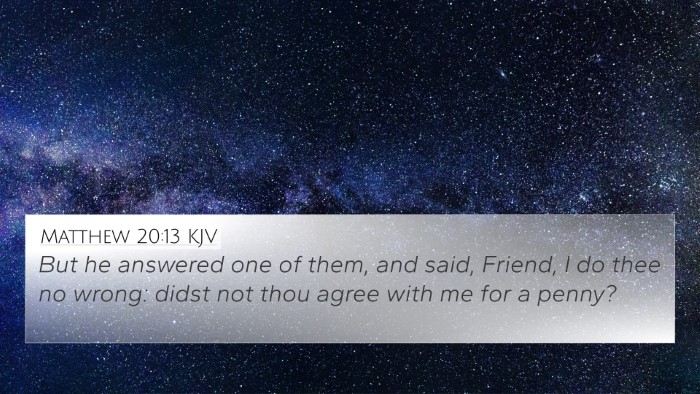Understanding Matthew 26:50
Verse: "And Jesus said unto him, Friend, wherefore art thou come? Then came they, and laid hands on Jesus and took him."
Overall Meaning
This verse captures the pivotal moment of Jesus' betrayal by Judas Iscariot. It reveals profound layers of friendship, betrayal, and divine purpose, showcasing Jesus' awareness of the impending events and His calm acceptance. Jesus addresses Judas as "Friend," highlighting the tragic irony of their relationship and Judah's role in the fulfillment of prophecy.
Commentary Insights
Matthew Henry's Commentary
Henry emphasizes the significance of Jesus calling Judas "Friend," which suggests a deep compassion even for the betrayer. This title may reflect:
- The mysterious love of Christ: Despite knowing Judas’ intentions, Jesus offers concern, indicating how God’s love extends even to those who betray Him.
- Fulfillment of scripture: This act aligns with prophecies concerning the Messiah. Judas’ betrayal was foretold, and this moment embodies that prophecy.
Albert Barnes' Commentary
Barnes elucidates on the chilling nature of the betrayal, noting how:
- Contextual betrayal: The act of betrayal carries historical weight, emphasizing the solemn nature of the moment, heightened by the fact that Judas was among Jesus' closest followers.
- Christ's demeanor: Jesus' calmness radiates authority, demonstrating that His surrender is voluntary, fulfilling His mission to redeem humanity.
Adam Clarke's Commentary
Clarke elaborates on the word "Friend", arguing it carries both affection and denunciation. He highlights:
- Contrast of intimacy and betrayal: Calling Judas friend emphasizes the tragedy of their relationship; although Judas was once close, he chose betrayal.
- Divine sovereignty: Clarke stresses this moment showcases God's sovereignty, emphasizing that even betrayal falls into His divine plan.
Cross-References to Consider
- Psalm 41:9: "Yea, mine own familiar friend, in whom I trusted, which did eat of my bread, hath lifted up his heel against me." - This verse foreshadows Judas’ actions.
- Matthew 26:14-16: Details Judas' agreement to betray Jesus for thirty pieces of silver.
- John 13:18: "I speak not of you all: I know whom I have chosen: but that the scripture may be fulfilled, He that eateth bread with me hath lifted up his heel against me." - Directly referencing Judas’ betrayal.
- Mark 14:43-45: A parallel narrative of the same event where Judas leads the soldiers to Jesus.
- Luke 22:47-48: Provides additional insights into the betrayal and Jesus' immediate response.
- Acts 1:16-20: Discusses the prophecy concerning Judas’ betrayal and the consequences that followed.
- Hebrews 10:29: Reminds us of the severity of turning from the truth once known, paralleling Judas' actions.
Connecting the Scriptures
The connections between these scriptures highlight a thematic Bible verse connection around betrayal, friendship, and prophecy:
- The betrayal of Jesus by Judas resonates throughout the Bible, often drawing comparisons to other instances of betrayal, connecting both Old and New Testament narratives.
- Understanding Matthew 26:50 enriches readers’ grasp of divine purpose, emphasizing how God’s plan unfolds even through human betrayal.
Conclusion
Matthew 26:50 stands as a stark reminder of the complexity of human relationships and God’s overwhelming grace. By understanding the dynamics of betrayal through scriptural cross-referencing, believers are encouraged to reflect on the nature of their own relationships, friendships, and the profound love of Christ, which transcends all understanding.








